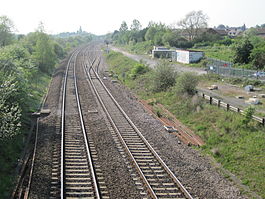Wootton Bassett railway station
| Wootton Bassett | |
|---|---|

View west towards the junction for South Wales and Bristol
|
|
| Location | |
| Place | Wootton Bassett |
| Area | County of Wiltshire |
| Coordinates | 51°32′05″N 1°54′05″W / 51.5346°N 1.9015°WCoordinates: 51°32′05″N 1°54′05″W / 51.5346°N 1.9015°W |
| Operations | |
| Original company | Great Western Railway |
| Platforms | 2 |
| History | |
| 1840 | First station opened |
| 1841 | Station opened in town |
| 1903 | Junction opened |
| 1965 | Station closed |
| Disused railway stations in the United Kingdom | |
| Closed railway stations in Britain A B C D–F G H–J K–L M–O P–R S T–V W–Z |
|
|
|
|
There have been three Great Western Railway (GWR) stations serving the town of Wootton Bassett in Wiltshire, England. The first was Wootton Bassett Road (1840-1841) which was some distance from the town, this was replaced by Wootton Bassett railway station (1841-1903) which was then rebuilt as Wootton Bassett Junction (1903-1965) to coincide with a new route to south Wales.
Sometimes referred to as 'Hay Lane' because of its location, the first station nevertheless appeared in timetables as 'Wootton Bassett Road'. It was a temporary terminus of the 7 ft (2,134 mm) broad gauge Great Western Main Line which was being built in stages from London Paddington station to Bristol. The railway was extended from Faringdon Road to Hay Lane on 17 December 1840. This was about 4 miles (6.4 km) by road east of Wootton Bassett.
Basic locomotive facilities were provided here, and road coaches carried passengers to Bath, where they could join another GWR train for the remainder of the journey to Bristol. The railway was opened from here to Chippenham on 31 May 1841 but the temporary station remained in use until 30 June 1841 and the locomotive facilities until sometime the following year.
The permanent station was opened on 30 July 1841, about 2.5 miles (4.0 km) west of Hay Lane. This was the same day that the railway was completed through the Box Tunnel so that trains could finally run the whole way from London to Bristol. The railway was double track with a platform on each side of the line and a small stone building on each. The main offices were on the north side of the line but a goods shed was provided on the south side at the London end of the platform. In 1850, an excursion train collided with a horsebox that had escaped from a siding at the station. Following this accident, the Great Western Railway provided trap points and scotch blocks at all sidings that exited onto running lines.
...
Wikipedia
